B2.1 Use the properties of operations and the relationships among addition, subtraction, multiplication, and division to solve problems involving whole numbers, including problems requiring more than one operation, and check calculations.
Skill: Using the Properties of Operations
Understanding the properties of operations and the relationships between them allows for more flexible use.
A good operation sense relies on good knowledge of the relationships between numbers and between operations.
Understanding the properties of the operations allows one to develop efficient computational strategies; for example, since multiplication is distributive, one can compute \(5\; \times \;12\) by performing \(\left( {5\; \times \;10} \right)\; + \;\left( {5\; \times \;2} \right)\).
In the primary grades, students were able to approach some of these properties intuitively. Students in the junior grades need to understand the properties of the operations presented below and learn to use them in problem solving situations.
Commutative Property
Addition and multiplication are commutative. For example, the commutative property of addition can be demonstrated as follows: there are 44 apples in one basket and 32 in another. The total number of apples will be the same whether we add the apples in the first basket to the apples in the second basket or whether we do the opposite. Thus, \(44 + 32\) is equal to \(\ 32 + 44\) which is equal to 76. Students should recognize that if the terms of an addition are switched, the result remains the same.
We can also demonstrate the commutative property of multiplication. For example, \(\ 8 \times 3\) and \(\ 3 \times 8\).

The two previous arrangements represent the same total quantity, organized in two different ways. Therefore, they illustrate two different situations. For example, \(\ 8 \times 3\) is 8 rows of 3 objects, while \(\ 3 \times 8\) is 3 rows of 8 objects. It is important that students recognize the different representations.
An example from everyday life can also be used. For example, the teacher invites three students who have exactly one sibling to come up to the board and represent the number of children in their family. The total number of children is represented by \(\ 3 \times 2\) children, for a total of 6 children (Figure 1).
Next, teachers do the same with two children who have exactly three siblings. The total number of children is represented by \(\ 2 \times 3\) children, for a total of 6 children (Figure 2).
Figure 1

Figure 2

Source: translated from Guide d'enseignement efficace des mathématiques de la 4e à la 6e année, Numération et sens du nombre, Fascicule 1, Nombres naturels, p. 103
The 2 mathematical statements, \(3\; \times \;2\; = \;6\) and \(2\; \times \;3\; = \;6\), indicate the same result, even though the order of the factors is reversed. Students can then understand that 3 families of 2 children or 2 families of 3 children give a total of 6 children, without the situations being identical.
When using the commutative property of multiplication, we are more interested in the answer, regardless of the situation.
For example, even if we are looking for\(12\; \times \;2\), we can choose to calculate \(2\; \times \;12\) if the result is easier to obtain, even if the 2 expressions do not represent the same situation.
When first learning multiplication, students often think of multiplication as repeated addition. As they attempt to solve a variety of problems, they can use the commutative property of multiplication to develop a more efficient computational strategy.
For example, students who use repeated addition would recognize that \(2\; \times \;12\) is the same as two 12s or \(12\; + \;12)\) and is easier and less time-consuming to represent and calculate than \(2\; + \;2\; + \;2\; + 2\; + \;2\; + \;2\; + 2\; + \;2\; + \;2\; + 2\; + \;2\; + \;2\).
An array is an excellent visual model for representing the commutative property of multiplication.

Associative Property
In the expression \(15\; + \;13\; + \;17\), it is possible to combine 13 and 17 to obtain \(15\; + \;(13\; + \;17)\), which gives \(15\; + \;30\), or 45. We can also associate 15 and 13 to obtain \((15\; + \;13)\; + \;17\), which gives \(28\; + \;17\), or 45. The associative property of multiplication (for example, \(3 \times 2 \times 5\) is equal to \(3 \times(2 \times 5)\) or \(3\; \times \;2\; \times \;5\; = \;(3 \times \;2)\; \times \;5\)) is not easy to understand. Of course, it can be seen by doing and checking the results of both expressions, but this does not constitute understanding. To understand, one can use an extension of the model of an array using cubes.
In Figure 1, we see that there are 2 rows of 5 cubes, that is, \(2\; \times \;5\) cubes. In Figure 2, we see 3 layers of \(2 \times 5\) cubes representing \(3\; \times \;(2\; \times \;5)\) cubes.
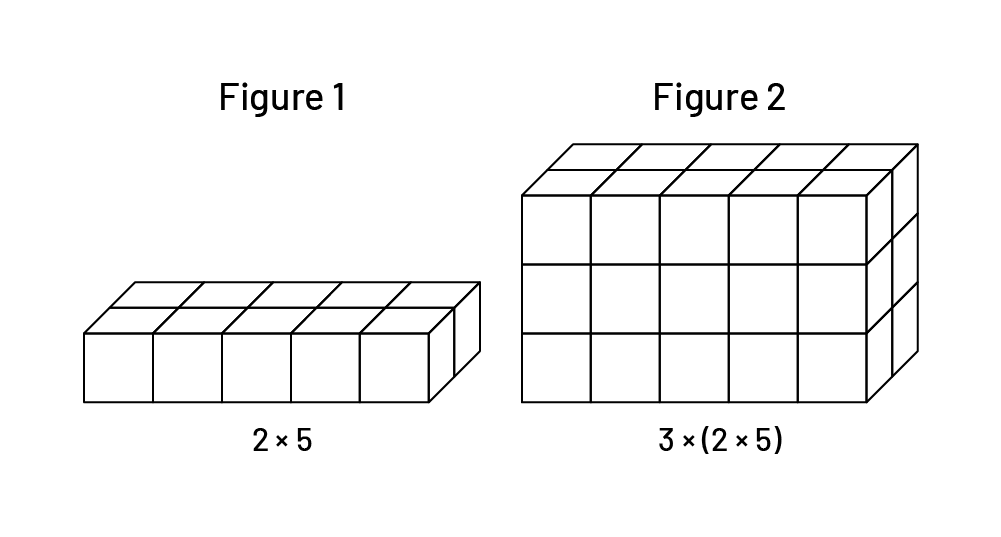
One can also consider Figure 3, which illustrates 3 layers of 2 cubes, that is, \(3\; \times \;2\) cubes. Figure 4 can then represent these cubes iterated 5 times, which is represented as \((3\; \times \;2)\; \times \;5\).
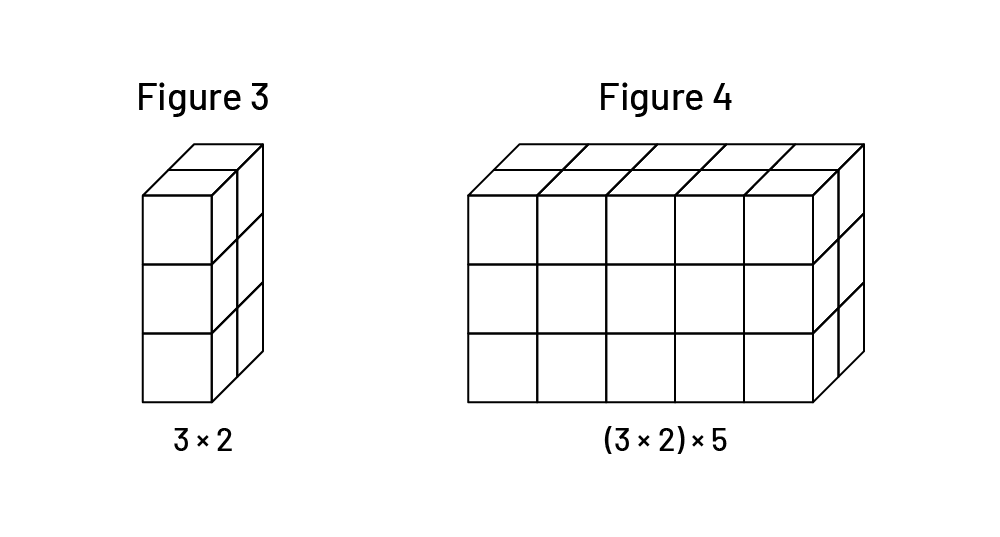
The associative property does not change the order of numbers in a numerical expression. We can see that\(3\; \times \;(2\; \times \;5)\) and \((3\; \times \;2)\; \times \;5\) represent the same amount of cubes (even though each expression represents a different configuration) and that each gives the same product as \(3\; \times \;2\; \times \;5\).
When faced with a numerical expression such as \(3\; \times \;(2\; \times \;5)\; = \;?\), students sometimes attempt to apply the distributive property in such a way that they calculate \(\left( {3\; \times \;2} \right)\; \times \;\left( {3\; \times \;5} \right)\), which results in \(2\; \times \;5\) multiplied by 9, rather than by 3. In such a case, remind students that the distributive property of multiplication is performed only on addition or subtraction and explain the situation using a concrete or visual (semi-concrete) model.
For example, to determine the value of the expression \(2\; \times \;3\; \times \;5\), you can determine the value of the expression \((2\; \times \;5)\; \times \;3\). It is usually easier to calculate \(10\; \times \;3\) than to calculate \(6\; \times \;5\). Similarly, to determine the value of the expression \(19\; + \;27\; + \;11\), one can determine the value of \((19\; + \;11)\; + \;27\), because 9 and 1 are complementary and make 1 ten, so the answer can more likely be obtained mentally, as \(30\; + \;27\; = \;57\). By exposing students to a wide range of activities, teachers can help them understand and use the different properties effectively.
The decomposition of a number into a product of factors, along with the associative property, can also be useful. For example, the number 24 can be represented by \(24\; \times \;1,\;12\; \times \;2,\;8\; \times \;3,\;6\; \times \;4\) or even \(2\; \times \;4\; \times \;3\) or \(2\; \times \;2\; \times \;2\; \times \;3\). To determine the value of a numerical expression such as \(24\; \times \;5\), students with good number sense and good operations sense may choose to transform 24 into \(12\; \times \;2\) and use the properties of operations as follows:
\(\begin{array}{l}24\; \times \;5\; = \,(12\; \times \;2)\; \times \;5\\24\; \times \;5\; = \,12\; \times \;2\; \times \;5\\24\; \times \;5\; = \,12\; \times \;10\\24\; \times \;5\; = \,120\end{array}\)
or
\(\begin{array}{l}24\; \times \;5\; = \,(12\; \times \;2)\; \times \;5\\24\; \times \;5\; = \,12\; \times \;5\; \times \;2\\24\; \times \;5\; = \,60\; \times \;2\\24\; \times \;5\; = \,120\end{array}\)
Distributive Property
Multiplication is distributive over addition. For example, you can multiply \(3\; \times \;\left( {5\; + \;6} \right)\) and get the same result as if you had done \(\left( {3\; \times \;5} \right)\; + \;\left( {3\; \times \;6} \right)\). Multiplication is also distributive over subtraction. For example, one can multiply \(3\; \times \;\left( {20\; - \;2} \right)\) by doing \(\left( {3\; \times \;20} \right)\; - \;\left( {3\; \times \;2} \right).\)
The following example illustrates how the distributive property can be used to calculate \(6\; \times \;8\). In the first case, we decompose the factor 8 into \(5\; + \;3\). Then we have \(6\; \times \;\left( {5\; + \;3} \right)\; = \left( {6\; \times \;5} \right)\; + \;\left( {6\; \times \;3} \right)\). In the second case, we decompose the factor 6 into \(3\; + \;3\). We then have \(\left( {3\; + \;3} \right)\; \times \;8\; = \left( {3\; \times \;8} \right)\; + \;\left( {3\; \times \;8} \right)\).

There is an important relationship between the distributive property and the usual multiplication algorithm. For example, to calculate \(3\; \times \;15\), the 15 is decomposed into \(\left( {10\; + \;5} \right)\):

To calculate \(13\; \times \;24\), the 2 factors are decomposed:

Only multiplication is distributive. However, division is partially distributive. For example, to calculate \(32\; \div \;8\), it is possible to decompose the dividend 32 into \(16\; + \;16\). We then have \((16\; + \;16)\; \div \;8\) and the division by 8 is distributed on the addition. We get \((16\; \div \;8)\; + \;(16\; \div \;8)\; = \;2\; + \;2\), which is 4. However, if the divisor is decomposed, the distributive property does not work. For example, \(32\; \div \;8\; \ne \;\left( {32\; \div \;4} \right)\; + \;\left( {32\; \div \;4} \right)\), showing that the distributive property does not apply to division.
Source: translated from Guide d'enseignement efficace des mathématiques de la 4e à la 6e année, Numération et sens du nombre, Fascicule 1, Nombres naturels, p. 102-105.
Sometimes a property may be used to check an answer. For example, \(4\; \times \;9\) may be first determined using the distributive property, \(2\; \times \;9\) + \(2\; \times \;9\) and then checked by decomposing \(4\; \times \;9\) into \(2\; \times 2 \times \;9\) and using the associative property \(2 \times \;(2\; \times \;9)\).
Source: adapted from Ontario Curriculum, Mathematics Curriculum, Grades 1-8 , 2020, Ontario Ministry of Education.
Skill: Using the Relationships Between Addition, Subtraction, Multiplication and Division
Understanding the relationships between operations allows them to be used more flexibly.
Addition, subtraction, multiplication and division are closely related despite their apparent differences. The more opportunities students have to work with the operations, the more they can notice and understand the relationships between them. Students may even use addition or subtraction strategies to solve multiplication and division.
In the primary grades, students have established relationships between operations through various activities. For example, students know that addition and subtraction are inverse operations and that addition is commutative. Over time, students develop their number sense and sense of operations and gradually use them before performing operations. This practice, while often informal and mental, is still essential to understanding the relationships between numbers and between operations.
Source: tranlated from Guide d’enseignement efficace des mathématiques de la 4e à la 6e année, Numération et sens du nombre, Fascicule 1, Nombres naturels, p. 97.
Addition and Subtraction
Addition and subtraction are inverse operations. Any subtraction question can be thought of as an addition question (for example, 154 - 48 = ? is the same as 48 + ? = 154 or ? + 48 = 154. This inverse relationship can be used to perform and check calculations.
However, when they are learning, students often have difficulty solving equations such as 17 + Δ= 31. Many teachers then encourage their students to use the inverse operation, subtraction. However, this can be a learning trick unless students understand why subtraction is a possible strategy. They must first grasp the relationship of the whole to its parts and the meaning of a difference.
For example, a number can be represented as follows:
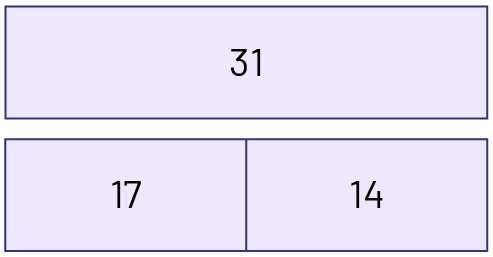
This way of representing the relationship between a number and its parts allows us to see that subtraction is the inverse operation of addition.
Thus, since \(17\; + \;14\; = \;31\;{\rm{or}}\;14\; + \;17\; = \;31\), then \(31\; - \;17\; = \;14\;{\rm{or}}\;31\; - \;14\; = \;17\). In addition, students can see why the commutative property applies to addition \((14\; + \;17\; = \;17\; + \;14\; = \;31)\) but not subtraction. Those who have developed good number sense and are able to decompose and group numbers can use their knowledge to more effectively solve equations such as \(17\; + \;\Delta \; = \;31\) by understanding that we are looking for the difference between 17 and 31.
Source: translated from Guide d'enseignement efficace des mathématiques de la 4e à la 6e année, Numération et sens du nombre, Fascicule 1, Nombres naturels, p. 97-98.
We can also use addition to solve a subtraction; this strategy is called "adding to subtract" or finding the missing addend. For example, to solve for \(\ 31 - 17 = ?\), the student can add from 17 to get to 31, that is, \(\ 17 + ? = 31\).
This inverse relationship can be used to perform and check calculations.
Multiplication and Division
Multiplication and division are also inverse operations. They can also be related to the concept of a whole and its parts. In multiplication, parts are grouped together as equal groups, while in division, a whole is broken down or partitioned into equal groups. Based on this relationship between multiplication and division, students can use multiplication facts to determine division facts. Students often misunderstand the inverse operation relationship between multiplication and division (for example, recognizing that \(39 \times \;6\; = \;234\) can be solved by \(234\; \div \;6\; = 39 \)), even after performing division and checking their calculations. It is therefore essential to regularly revisit the meaning of each of the operations in a problem-solving context.
Source: translated from Guide d’enseignement efficace des mathématiques de la 4e à la 6e année, Numération et sens du nombre, Fascicule 1, Nombres naturels, p. 98.
To understand multiplication and division, one must recognize the three types of quantities involved: the total quantity (for example, 8 flowers), the number of equal groups (for example, 4 pots), and the size of each group (for example, 2 flowers per pot).

In the problems presented to students, division is too often associated with only one type, namely equal-sharing (partitive division). Equal-grouping (quotative or measurement) division is usually neglected. With equal-sharing division, the total quantity and the number of groups are known and the size of the groups is unknown (for example, 3 students want to share 15 apples equally, we look for the number of apples each student will receive).

With equal-grouping division, the total quantity and the size of groups are known and the number of groups is unknown (for example, we have 15 apples and we want to put them in bags, 3 apples per bag; we look for the number of bags we need).

It is essential that both types of situations be addressed, as they are the basis for the integration of other mathematical concepts. It is not necessary for students to know the names of the situation types, but it is essential that they have the opportunity to solve a variety of problem types, while using a variety of strategies.
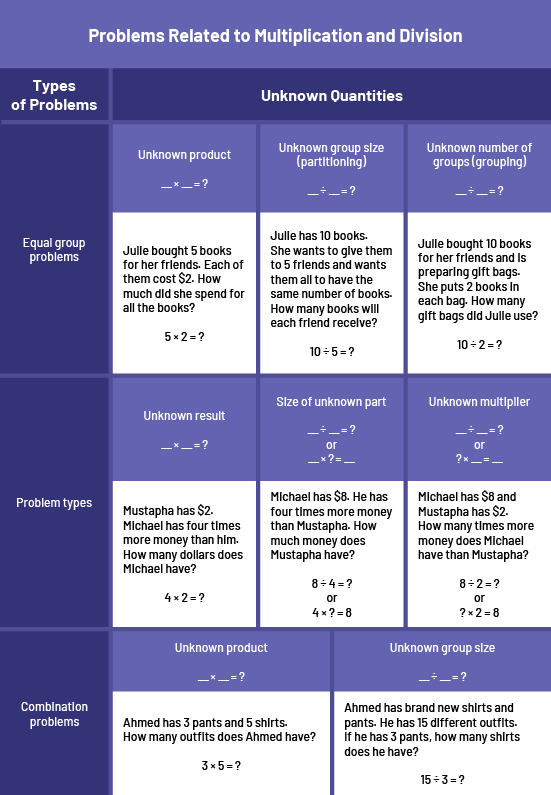
Source: translated from Guide d'enseignement efficace des mathématiques de la 4e à la 6e année, Numération et sens du nombre, Fascicule 1, Nombres naturels, p. 84-86.
Multiplication and Addition
The connection between multiplication and addition is often the starting point for introducing students to the concept of multiplication.
Early in learning multiplication, students recognize that the situation presents the same quantity "many times" and use equal groups to represent the situation and repeated addition to get the answer. As students progress, it is important that they see the concept as multiplication rather than addition and learn other representations. The array, an arrangement of rows and columns, is a powerful model for learning multiplication and provides a different perspective on multiplication.

By solving a variety of problems and discussing strategies, students come to make and understand the connection between the word "times" and the sign "times", a crucial step in developing an understanding of multiplication. Once their sense of multiplication is well established, they will use multiplication more regularly to obtain answers.
Source: translated from Guide d'enseignement efficace des mathématiques de la 4e à la 6e année, Numération et sens du nombre, Fascicule 1, Nombres naturels, p. 84-85.
Division and Subtraction
Similarly, division can be associated with repeated subtraction, but not in the same way. The product of a multiplication is equal to the sum resulting from the repeated addition, whereas the quotient of a division is equal to the number of repeated subtractions (for example, to calculate \(20\; \div \;5\) we would do \(20\; - \;5\; = \;15, \;15\; - \;5\; = \;10, \;10\; - \;5\; = \;5, \;5\; - \;5\; = \;0\) ; we subtracted 4 times; therefore \(20\; \div \;5\; = \;4\)).
It takes time for students to learn these relationships. To support them, teachers can use hands-on activities, problem solving, and mathematical discussions that focus on the relationships between operations.
Source: translated from Guide d'enseignement efficace des mathématiques de la 4e à la 6e année, Numération et sens du nombre, Fascicule 1, Nombres naturels, p. 98-99.
Impact of the Mathematical Operations
Each operation has an impact on the quantities involved. Depending on the operation, certain quantities increase or decrease. They may increase or decrease by a lot or a little. Tracking the impact of the operations on numbers allows students to build relationships between operations and to anticipate the result of an operation. For example, if we subtract 8 from 160, we will notice little impact because the difference between 160 and 152 is relatively small. However, if we divide 160 by 8, the impact is greater, because the resulting quotient, 20, is much smaller than 160. We can also compare the impact of addition with that of multiplication. Compared to multiplication, addition increases a number by a small amount. For example, when 160 is multiplied by 8, you get 1280, whereas if you add 8, you get 168. People with good operations sense recognize the impact of operations on whole numbers, but students who are learning are often impressed by the impact of, for example, multiplication. A word of caution: care must be taken when generalizing, as operations on decimal numbers or fractions may have a different impact than those on whole numbers. In some cases, the impact may even be the opposite. For example, if you multiply one whole number by another whole number, the product is larger than both factors (for example, if you multiply 3 by 6, the product 18 is larger than 6 and 3), whereas if you multiply a proper fraction by a whole number, the product is smaller than one of the factors (for example, if you multiply \(\frac{1}{2}\) by 6, the product 3 is smaller than 6).
Source: translated from Guide d'enseignement efficace des mathématiques de la 4e à la 6e année, Numération et sens du nombre, Fascicule 1, Nombres naturels, p. 90-91.
Skill: Solving Problems Requiring Multiple Operations
Whether it is a problem with one operation or multiple operations, students must make decisions and choices based on the context. A problem-solving approach will introduce them to this thinking. When faced with a problem, they must first analyze it to determine the data and understand that a calculation must be performed. Then, depending on the context, one must know whether one is looking for an approximate or an exact answer. In both cases, depending on the context and the numbers involved, it is then necessary to determine whether the calculation will be performed mentally, in writing or using a calculator. Finally, the desired calculation is performed.
Diagram of the Students' Thinking About a Problem
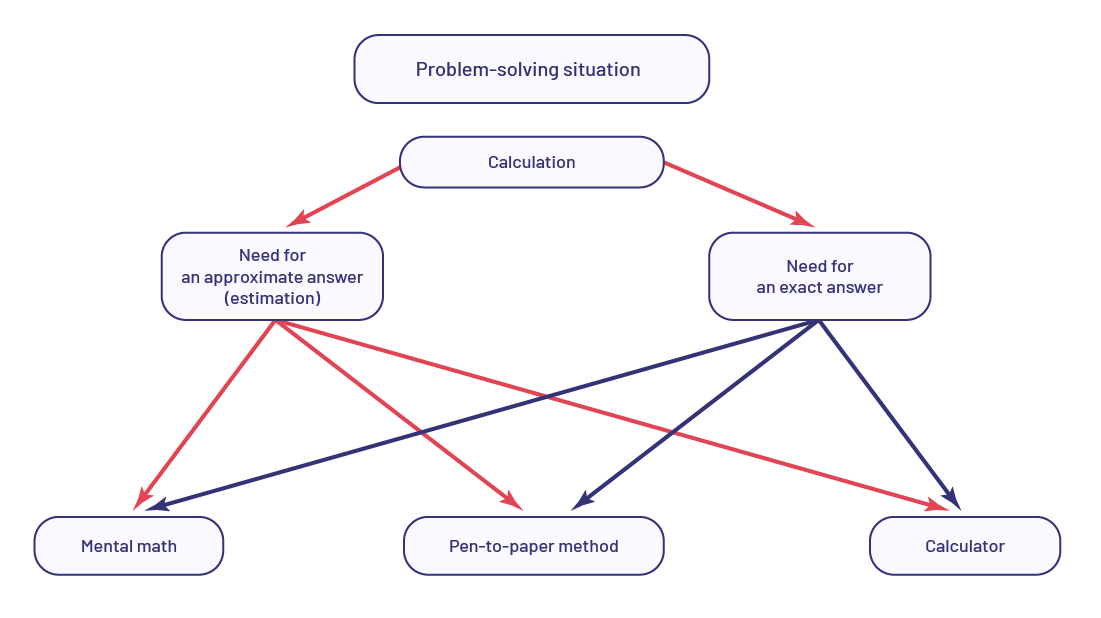
Source: translated from Guide d'enseignement efficace des mathématiques de la 4e à la 6e année, Numération et sens du nombre, Fascicule 1, Nombres naturels, p. 117.
Knowledge: Properties of Operations
A property of an operation is a characteristic that is specific to the operation, regardless of the numbers involved.
The properties of operations are:
- Commutative Property: \(\left( {3\; + \;5\; = \;5\; + \;3} \right)\);
- Associative Property: \(\left( {2\; + \;9)\; + \;11\; = \;2\; + \;(9\; + \;11} \right)\);
- Distributive Property: \(8\; \times \;7\; = \;\left( {8\; \times \;5} \right)\; + \;\left( {8\; \times \;2} \right)\);
- Identity Principle: \(13\; + \;0\; = \;13\), \(0\; + \;13\; = \;13\); \(25\; \times \;1\; = \;25\), \(1\; \times \;25\; = \;25\);
- Zero Property of Multiplication: \(8\; \times \;0 = \;0\)
Source: translated from Guide d'enseignement efficace des mathématiques de la 4e à la 6e année, Numération et sens du nombre, Fascicule 1, Nombres naturels, p. 102
Knowledge: Commutative Property
An operation is commutative if its result remains unchanged when the order of its terms is reversed. Addition and multiplication are commutative. For example, \(27\; + \;63\; = \;63\; + \;27\) and \(8\; \times \;6\; = \;6\; \times \;8\).
Source: translated from Guide d'enseignement efficace des mathématiques de la 4e à la 6e année, Numération et sens du nombre, Fascicule 1, Nombres naturels, p. 102.
Knowledge: Associative Property
The associative property of addition and multiplication allows you to combine the terms or factors of an expression in different ways without changing the value of the expression. For example, \(3\; \times \;2 \; \times \;5\; = \;3\; \times \;\left( {2\; \times \;5} \right)\).
Source: translated from Guide d'enseignement efficace des mathématiques de la 4e à la 6e année, Numération et sens du nombre, Fascicule 1, Nombres naturels, p. 105.
Knowledge: Distributive Property
Multiplication is distributive over addition and subtraction.
The distributive property allows one to perform an operation on a sum or a difference of terms and obtain the same result as if the operation had been performed on each term. For example,
- we can multiply \(3\; \times \;\left( {5\; + \;6} \right)\) and obtain the same result as if we had performed \(\left( {3\; \times \;5} \right)\; + \;\left( {3\; \times \;6} \right)\);
- we can multiply \(3\; \times \;\left( {20\; - \;2} \right)\) by performing \(\left( {3\; \times \;20} \right)\;-\;\left( {3\; \times \;2} \right)\).
Source: inspired by and translated from Guide d'enseignement efficace des mathématiques de la 4e à la 6e année, Numération et sens du nombre, Fascicule 1, Nombres naturels, p. 104.
Knowledge: Zero Property of Multiplication
When multiplying any number by zero, the result is zero (for example, \(684\; \times \;0\; = \;0\)) and also, zero groups of anything is nothing (for example, \(0\; \times \;684\; = \;0\)).
Source: inspired by and translated from Guide d'enseignement efficace des mathématiques de la 4e à la 6e année, Numération et sens du nombre, Fascicule 1, Nombres naturels, p. 107.
Knowledge: Relationships Between Addition, Subtraction, Multiplication and Division
Operational sense involves the ability to represent situations with symbols and numbers. Understanding the meaning of the operations, and the relationships between them, allows one to choose the operation that best represents a situation and allows one to solve the problem most effectively, given the tools available.
- Addition and subtraction are inverse operations.
- Multiplication and division are inverse operations.
- Multiplication can be associated with repeated addition.
- Division can be associated with repeated subtraction.
